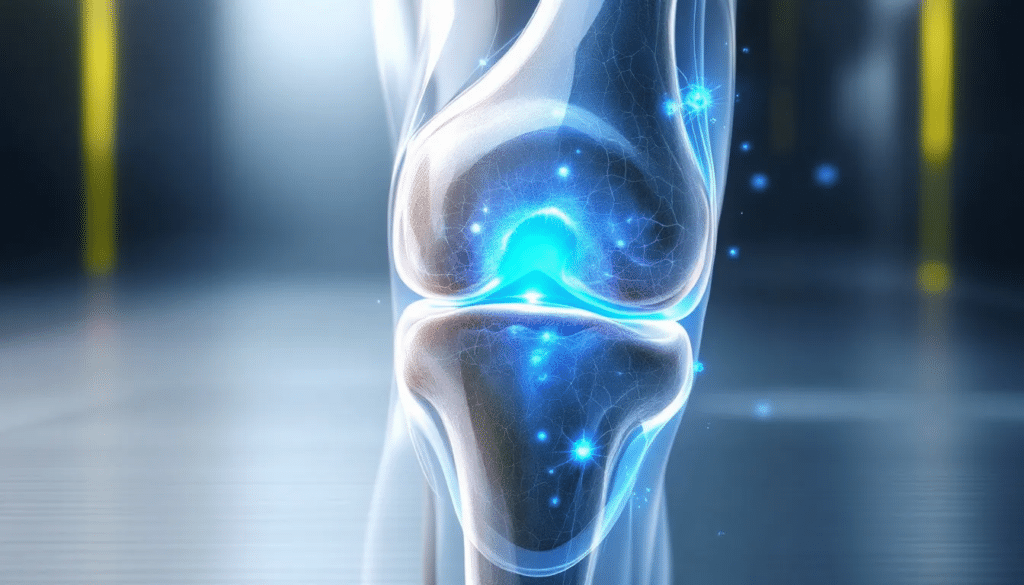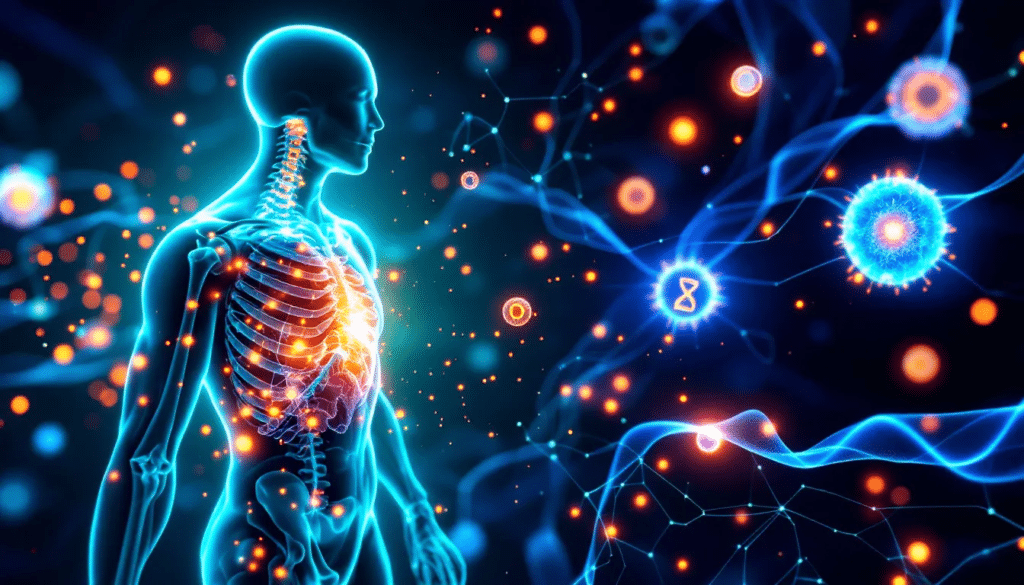Can stem cells regrow cartilage? Yes, research shows that stem cells have the potential to help regenerate damaged cartilage. This article explores how stem cells work in cartilage repair, the different types of stem cells used, including adult stem cells, and the current clinical evidence supporting this groundbreaking therapy.
Introduction to Regenerative Medicine
Regenerative medicine is a rapidly evolving field that aims to repair or replace damaged tissues and organs using innovative therapies. This approach has shown great promise in treating various diseases and conditions, including osteoarthritis (OA). By harnessing the power of stem cells, bioengineering, and gene therapy, regenerative medicine seeks to stimulate the body’s natural healing response, offering new hope for patients with chronic ailments.
Stem cells, in particular, play a pivotal role in regenerative medicine. These remarkable cells have the ability to differentiate into various cell types, making them invaluable for repairing damaged tissues. In the context of osteoarthritis, stem cell therapy aims to regenerate damaged cartilage, alleviate pain, and improve joint function. Researchers and clinicians are continually exploring new ways to utilize stem cells and other regenerative techniques to develop effective treatments for OA and other debilitating conditions.
The potential of regenerative medicine extends beyond just treating symptoms; it aims to address the root cause of tissue damage, offering long-term solutions and improved quality of life for patients. As research progresses, the integration of stem cells and other regenerative therapies into mainstream medical practice holds the promise of revolutionizing the treatment landscape for osteoarthritis and many other chronic diseases.
Key Takeaways
Stem cells, particularly mesenchymal stem cells (MSCs), show significant potential for regenerating damaged cartilage due to their ability to differentiate into chondrocytes and promote healing.
Recent clinical studies indicate that stem cell therapies can enhance cartilage repair, alleviate pain, and improve joint function, particularly in patients with osteoarthritis.
Challenges such as stem cell retention, homing, standardization, and regulatory issues must be addressed to optimize the efficacy and adoption of stem cell therapies for cartilage regeneration.
Understanding Cartilage Damage

The extraordinary tissue known as articular cartilage facilitates smooth, pain-free joint movement. Nevertheless, it comes with a major limitation: the capacity to self-repair is greatly hindered by its lack of blood flow and minimal cell presence. As a consequence, any harm inflicted upon this cartilage becomes notably problematic because the natural recuperative mechanisms of the body are insufficiently effective. For individuals who lead an athletic or active lifestyle, sustaining injuries to their cartilage can be frequent and potentially put their careers in jeopardy.
Various factors contribute to damage within the cartilaginous tissue, such as sports-related trauma and chronic conditions like osteoarthritis. The deterioration of this crucial substance often results in intense joint discomfort along with mobility restrictions for those affected. If issues related to damaged cartilage go unaddressed over time, they could evolve into osteoarthritis – an intensely incapacitating illness that profoundly diminishes one’s life quality.
Distinguishing between two primary forms of injury seen within articular structures is essential. These consist of chondral defects which solely impair surface-level layers without vascular access—thus relying on sparse native chondrocytes—and full-thickness (osteochondral) afflictions that penetrate through both layers right down into subchondral bone areas where increased vascularity promotes healing facilitated by bone marrow-derived cells.
Experiencing complications from impaired articular structures significantly inhibits not only functional movements but also inflicts severe joint discomforts which impede day-to-day living standards while adversely affecting general healthiness and well-being satisfaction levels too—a realization that underscores just how pivotal regenerative approaches like stem cell therapy might prove when aiming at remedying such ailments effectively.
Understanding Articular Cartilage
Articular cartilage is a complex and specialized tissue that covers the ends of bones in joints, facilitating smooth and pain-free movement. This resilient tissue is composed of a dense matrix of collagen fibers, proteoglycans, and chondrocytes—the only cells found in healthy cartilage. The primary function of articular cartilage is to reduce friction and absorb shock during joint movement, thereby protecting the underlying bone.
One of the unique characteristics of articular cartilage is its avascular nature, meaning it lacks blood vessels. This avascularity, combined with the absence of nerve endings (aneural), makes cartilage particularly challenging to repair. Unlike other tissues in the body that can rely on blood flow to deliver nutrients and remove waste, cartilage must depend on the limited supply of nutrients diffused from the surrounding joint fluid. This limited nutrient supply hinders the natural repair processes, making it difficult for damaged cartilage to heal on its own.
In conditions like osteoarthritis, the wear and tear of articular cartilage lead to its gradual degradation, resulting in pain, inflammation, and reduced joint function. The inability of cartilage to self-repair exacerbates these issues, highlighting the need for innovative treatments like stem cell therapy to promote cartilage regeneration and restore joint health.
The Role of Stem Cells in Cartilage Regeneration

Stem cells have become a focal point in regenerative medicine thanks to their remarkable ability to transform into diverse cell types and foster the healing process. Embryonic stem cells, known for their versatility and pluripotency, show potential in differentiating into chondrogenic cells for cartilage regeneration. Specifically, mesenchymal stem cells (MSCs), which are derived from various tissues including bone marrow, adipose tissue (fat), and umbilical cord blood, possess the capability to differentiate into cartilage cells. This property is crucial for assisting in the restoration of damaged cartilage.
In recent times, utilizing stem cell therapy as an avenue for repairing cartilage has gained increasing interest within scientific research circles. Advances in mesenchymal stem cell therapy highlight the role of pluripotent stem cells in facilitating tissue regeneration and repair for osteoarthritis. Early-stage studies suggest that MSCs harvested from umbilical cords or placentas may promote improved outcomes when introduced into joints afflicted by damage—they not only catalyze new cartilage growth but also alleviate inflammation within these joints. Due to their inherent immunomodulatory functions, these cells pose a lowered rejection risk post-transplantation into patients.
The prospect of harnessing different forms of stem cells—including MSCs extracted from bone marrow (BMSCs) or those obtained from adipose tissue (ADSCs)—for enhancing cartilage regeneration presents exciting potential benefits. The subsequent sections will provide more detailed insights on how each type contributes distinctively towards facilitating repair and rejuvenation in damaged-cartillage tissues.
Mesenchymal Stem Cells (MSCs)
Autologous mesenchymal stem cells, particularly mesenchymal stem cells (MSCs), hold significant promise for the regeneration of cartilage. They possess the distinctive property of differentiating into chondrocytes, which are essential in forming cartilage tissue. This transformation is pivotal for enhancing joint functionality over time and presents MSCs as a crucial resource in combating conditions like osteoarthritis that affect joints.
One key benefit of employing MSCs in repairing cartilage is their innate ability to self-renew and their pluripotent nature, enabling them to be precisely injected into the affected joint space directly. Such localized administration promotes accurate placement of these cells at injury sites, thereby increasing treatment efficacy. Sources such as the umbilical cord and placental tissues serve as origins for deriving these powerful regenerative MSCs.
The application of MSCs sourced from umbilical cords and placentas holds exceptional appeal due to their availability in large quantities along with advantageous immunomodulatory attributes that minimize rejection risks during therapy sessions aimed at restoration purposes. For individuals experiencing cartilage degeneration and associated joint discomfort, this burgeoning field offers considerable optimism through potential therapeutic interventions based on these unique types of stem cells.
Bone Marrow-Derived Stem Cells (BMSCs)
Stem cells derived from bone marrow, known as bone marrow-derived mesenchymal stem cells (BM-MSCs), represent a potent avenue for the restoration of cartilage, particularly through intra-articular injections for treating knee osteoarthritis. These stem cells can be sourced with relative ease through bone marrow aspirate concentrate, providing a viable and readily available option for regenerative therapies. The capacity of these cells to transform into various types of tissue such as bone and cartilage underscores their adaptability in treatments aimed at joint recovery.
The success achieved in mending damaged cartilage is significantly influenced by pinpointing suitable endogenous sources of stem cells and their respective environments conducive to regeneration. In this context, BM-MSCs prove particularly beneficial due to their ability under optimal conditions to differentiate and aid in both the repair and renewal processes associated with cartilage healing – reasons why they are frequently utilized within joint therapy settings including osteoarthritis treatment scenarios.
As powerful agents that possess the capability to evolve into multiple forms of tissues, including but not limited to cartilaginous substances, bones, along with other supportive connective frameworks within our anatomy, Bone Marrow Stem Cells (BMSCs) continue to gain prominence throughout practices dealing with regenerative medicine. Their multifaceted nature combined with effective reparative qualities positions them as crucial contributors towards addressing ailments related, especially joint deterioration, while alleviating affiliated discomforts.
Adipose-Derived Stem Cells (ADSCs)
Stem cells derived from adipose tissue, known as ADSCs, are extracted from the body’s fat reserves and present a potent option for joint repair within regenerative medicine. The collection process of these stem cells is relatively non-invasive, which presents a desirable choice for individuals undergoing treatment.
In the realm of cartilage regeneration, especially in tackling conditions such as osteoarthritis, ADSCs offer considerable promise. They possess the ability to morph into different types of cells, including those that form cartilage. This capability enables them to foster healing by repairing damaged tissues and underscores their significance in regenerative medical applications.
Utilizing ADSCs in restoring cartilage points to the remarkable capacity of stem cells to aid recovery processes and enhance functionality within joints. Their straightforward extraction method paired with their therapeutic potential places them at the forefront for individuals grappling with joint discomfort or injury related to cartilage deterioration.
Mechanisms of Action: How Stem Cells Promote Healing
The potential of stem cells in the field of regenerative medicine is greatly attributed to their ability to facilitate healing. Hematopoietic stem cells, residing in the bone marrow, are crucial as they give rise to various blood cells, including white blood cells, red blood cells, and platelets, and their understanding is vital for advancements in regenerative medicine. Central to this realm is the aim of augmenting and harnessing the body’s inherent repair mechanisms. Stem cells contribute by delivering bioactive molecules that possess curative properties as well as generating exosomes, which are instrumental in these processes.
In promoting recovery, stem cells employ paracrine signaling pathways that emit factors attenuating inflammation and bolstering repair activities. The vital functions these bioactive substances serve include fostering a conducive environment for tissue renewal. Current research delves into how stem cell-derived exosomes could potentially advance cartilage regeneration, thereby enhancing restorative outcomes.
An examination into how bioactive molecules and exosomes operate conjointly in encouraging cartilage regeneration while simultaneously mitigating inflammatory responses will offer greater insight into the supportive role played by stem cells within healing modalities.
Bioactive Molecules and Inflammation Reduction
Stem cells emit bioactive molecules that play a vital role in decreasing inflammation and promoting an environment conducive to regeneration. These secretions, which consist of various proteins and growth factors, are essential for curbing inflammation—an important factor for recovery. By mitigating inflammatory responses, these substances help establish favorable conditions for tissue repair.
By emitting these pivotal molecules, stem cells contribute to the alleviation of the inflamed state present in osteoarthritic joints—a condition that can impede chondrogenic differentiation within stem cells. Diminishing such inflammation is imperative for successful cartilage regeneration because it enables stem cells to operate at their best capacity and facilitate healing processes.
The reduction of inflammation by way of creating a supportive environment is one primary strategy through which stem cells assist with cartilage restoration. Harnessing the potential offered by the bioactive compounds produced by stem cells is central to advancing regenerative treatments aimed at repairing damaged tissues.
Exosomes and Their Regenerative Potential
Tiny vesicles known as exosomes, produced by stem cells, are being recognized for their potential in tissue regeneration. These small packages transport a range of regenerative molecules such as proteins and RNA to areas of damage, aiding in the repair and generation of new cartilage by fostering an environment suitable for healing.
These particulate elements from stem cells significantly contribute to creating conditions that favor the mending process within damaged cartilage. Their capacity to mitigate inflammation alongside promoting fresh cartilage growth positions them as a vital component in cell therapy targeted at repairing deteriorating joint tissues.
In particular, exosomes originating from mesenchymal stem cells have demonstrated effectiveness in encouraging the restoration of cartilage tissue. This development holds great promise for providing enduring relief to individuals affected by joint discomfort due to progressive loss of cartilage integrity. Continued exploration into how these tiny carriers can enhance stem cell therapies is imperative for advancing treatment options.
Recent Research and Clinical Evidence

Recent studies and evidence from clinical practices underscore the significant role of stem cell therapy in facilitating cartilage regeneration. Clinical research indicates that administering intra-articular injections composed of bone marrow-derived stem cells can amplify pain alleviation and advance joint functionality for those suffering from osteoarthritis. Such findings highlight the substantial therapeutic advantages that stem cell therapies might provide.
Initial results following injection with adipose-derived stem cells (ADSC) have reported zero adverse reactions, alongside considerable therapeutic gains. These outcomes emphasize both the safety and efficacy of utilizing stem cell-based treatments for managing joint-related disorders such as osteoarthritis. The pivotal role played by clinical investigations is apparent. They offer critical support validating the use of various types of stem cells within regenerative medicine’s scope.
In our discussion, we will bring forth extensive insights derived from imaging assessments and numerous clinical trials, which illustrate the encouraging effects and promising future that lies ahead for using cell therapy to foster cartilage restoration.
Imaging Studies Showing Cartilage Regrowth
Assessing the impact of stem cell therapy on cartilage repair is significantly aided by imaging studies, which offer clear visual confirmation of any alterations to the condition of cartilage. This provides a concrete assessment of the success rate for such therapies. The injection of mesenchymal stem cells (MSCs) in patients frequently leads to reduced deterioration and actual regrowth of cartilage as seen through diagnostic images, suggesting possible healing.
Exosomes derived from MSCs have demonstrated their ability to lessen inflammation and create an environment conducive to the regeneration process within damaged cartilage areas. It’s this capacity that plays a key role during recovery since it facilitates genuine tissue restoration instead of merely providing temporary symptom relief.
Employing MSC treatment could potentially result in sustained relief from discomfort by directly stimulating natural processes for rebuilding deteriorated joint surfaces—fostering optimism among those afflicted with chronic joint pain disorders. These findings from imaging assessments highlight how cell therapy anchored around stem cells can offer enduring remedies against ongoing issues related to both persistent joint pain and injury-induced damage within joints.
Clinical Trials and Patient Outcomes
Clinical trial results have strongly endorsed the effectiveness of stem cell therapy in treating osteoarthritis and similar conditions affecting joints. Individuals who undergo this form of treatment frequently report notable enhancements in both their pain levels and movement capabilities, underscoring stem cells’ capacity to mitigate symptoms connected with osteoarthritis.
Investigations indicate that a substantial number of patients show marked improvements regarding arthritis-related discomfort following stem cell therapy sessions. These advancements can potentially postpone the necessity for more aggressive treatments such as joint replacement surgery, thus providing an alternative approach that is less invasive for those affected.
Following cell therapy using stem cells, many patients have reported experiencing diminished joint pain along with an increased ability to move freely. Such positive outcomes emphasize the value of utilizing stem cell therapies in addressing issues related to joint distress and damage to cartilage tissue, ultimately enhancing the overall well-being of individuals receiving such treatments.
Challenges in Stem Cell Therapy for Cartilage Regeneration

Despite the substantial promise of stem cell therapy in promoting cartilage regeneration, there are several hurdles that must be overcome. The data supporting the effectiveness of mesenchymal stem cells (MSCs) for repairing cartilage is somewhat encouraging but not conclusive, indicating an urgent need for more research and clinical trials to verify these therapies’ efficacy.
Among the primary concerns is confirming both safety and successful outcomes from stem cell treatments. Early results involving injections with bone marrow aspirate concentrate for treating osteoarthritis have shown potential, yet comprehensive studies are necessary to solidify these findings. Certain regenerative procedures remain unapproved by the FDA for arthritis treatment, which complicates broader acceptance.
The issues we intend to delve into include those related to securing effective retention and targeting (“homing”) of injected stem cells as well as tackling standardization and regulatory challenges associated with implementing cell therapy on a wider scale.
Retention and Homing of Stem Cells
The main obstacle in stem cell therapy is the difficulty of keeping stem cells at the site of injury. The tendency for these cells to migrate away, coupled with low targeting efficiency, presents a major challenge. Due to its high density and negative charge, cartilage matrix makes it tough for stem cells to infiltrate effectively.
Making targeted adjustments can improve mesenchymal stem cells’ (MSCs) ability to home in on injuries by boosting their migration and binding capabilities at those sites. This homing efficacy can be Increased substantially through the application of certain compounds and cytokines that act as external factors guiding MSCs toward areas afflicted with cartilage defects.
The use of biomaterial-based scaffolds that incorporate cell-homing peptides is a promising strategy for promoting precise delivery and better retention of stem cells at sites requiring repair. Effective anchoring and navigation towards injured regions are essential aspects contributing to how MSCs aid in healing damaged cartilage tissue successfully through regenerative processes.
Standardization and Regulatory Issues
The widespread adoption of stem cell therapy for the repair and regeneration of cartilage is impeded by substantial challenges related to standardization and regulatory concerns. The uniformity in quality and performance measures of stem cells remains vital for their dependable use within this context. Existing frameworks from hematopoietic cell product regulation may serve as a model, providing an avenue toward greater consistency in protocols applied to therapies aimed at regenerating cartilage.
Consumers are cautioned by the FDA regarding claims associated with unverified stem cell treatments, particularly due to insufficient evidence backing many such procedures’ effectiveness. This caution specifically extends to those therapies purportedly treating osteoarthritis with stem cells that have yet failed to demonstrate conclusive benefits.
For stem cell-based therapeutic approaches—especially those focused on healing damaged cartilage—to gain more traction and credibility within medical practices, overcoming these hurdles relating to standardization and meeting regulatory benchmarks is essential. Only by addressing these issues can we ensure a broader clinical application of safe and effective stem cell treatments.
Future Directions in Stem Cell Therapy
Regenerative medicine is making strides in capitalizing on the body’s innate ability to heal, with stem cell therapy at the forefront of facilitating cartilage regeneration. Skeletal stem cells (SSCs) show significant potential in cartilage repair and regeneration due to their robust chondrogenic capabilities compared to other stem cell types like mesenchymal stem cells (MSCs). The emphasis lies in bolstering and tapping into our natural reparative processes—a key aspect that will continue to shape the trajectory of stem cell therapies.
Factors such as aging and obesity can impede both the quality and efficacy of stem cells when used for therapeutic purposes. It’s imperative that these influences are addressed to better harness successful outcomes from stem cell treatments. Identifying suitable endogenous targets for these cells, as well as their specific environments or niches, is vital in advancing positive results within cartilage regeneration techniques.
Looking ahead, we’ll delve into some forward-thinking strategies including advanced scaffold methods aimed at improving retention rates and integrating mesenchymal stem cells (MSCs) with anti-inflammatory agents—offering a glimpse into cutting-edge methodologies poised to enhance future endeavors in cell therapy.
Scaffold Techniques for Enhanced Retention
Scaffolding methods are integral to improving the localization of stem cells at sites of cartilage damage. These bioactive scaffolds have the capability to attract and engage endogenous stem cells, directing them towards areas that require healing. This specificity is crucial for amplifying the success rates of therapies involving stem cells.
Progressive advancements in scaffold technology are aimed at boosting the retention capabilities for stem cells within affected zones. By retaining these essential healing components where they’re most needed, these innovations promise marked improvements in fostering cartilage regeneration and facilitating repair processes.
This leap in scaffolding innovation marks a pivotal moment for regenerative medicine by offering promising enhancements to treatments centered on repairing damaged cartilage with more effective application and potential outcomes using stem cell-based interventions.
Combining MSCs with Anti-Inflammatory Treatments
Merging mesenchymal stem cells with anti-inflammatory treatments could be beneficial for safeguarding the health of cartilage and bolstering repair results amid inflammatory conditions. This synergistic method has shown to significantly boost the success rate of stem cell therapy when addressing joint issues such as osteoarthritis.
The enhancement in preservation and extension of healthy cartilage provided by this dual approach is crucial for sustaining joint functionality and motion. By curbing inflammation and encouraging recovery, it can help uphold the structure of cartilage thereby averting its Breakdown.
Uniting MSCs with anti-inflammatory measures stands out as an exciting advancement in regenerative medicine, presenting a potential leap forward toward more effective, all-encompassing remedies for alleviating joint discomfort and repairing damaged cartilage.
Recruiting and Stimulating Endogenous Stem Cells
Endogenous stem cells, such as mesenchymal stem cells (MSCs), play a crucial role in maintaining tissue homeostasis and promoting repair. These versatile cells have the ability to differentiate into various cell types, including chondrocytes (cartilage cells), osteoblasts (bone cells), and adipocytes (fat cells). By recruiting and stimulating endogenous stem cells, researchers aim to enhance the body’s natural repair mechanisms, promoting cartilage regeneration and reducing the symptoms of osteoarthritis.
One promising strategy involves the use of growth factors and cytokines to attract and activate MSCs at the site of cartilage damage. These bioactive molecules can create a favorable environment for stem cells to thrive and differentiate into the necessary cell types for tissue repair. Additionally, certain compounds can be used to enhance the homing capabilities of MSCs, ensuring they reach the damaged areas more effectively.
Another approach is the use of bioactive scaffolds that incorporate cell-homing peptides. These scaffolds not only provide structural support but also help guide endogenous stem cells to the injury site, improving their retention and promoting more efficient cartilage regeneration. By combining these techniques, researchers hope to develop more effective treatments that leverage the body’s own repair mechanisms to restore healthy cartilage and improve joint function.
In summary, the recruitment and stimulation of endogenous stem cells represent a promising avenue in regenerative medicine. By enhancing the natural healing processes, these strategies hold the potential to significantly improve outcomes for patients with osteoarthritis and other conditions involving cartilage damage.
Potential Benefits of Stem Cell Therapy for Cartilage Regeneration

The therapeutic application of stem cells holds numerous possible advantages for the regeneration of cartilage. It has the capacity to foster cartilage regrowth, offering a durable remedy for joint pain and functional difficulties. This aspect is particularly critical for individuals grappling with ailments such as osteoarthritis, where the degradation of cartilage presents a major challenge.
Stem cell treatments have shown potential in diminishing discomfort and augmenting joint function, thereby enhancing patients’ overall well-being. The utilisation of mesenchymal stem cells (MSCs), which can be procured from a patient’s own body tissue, paves the way for customised therapies that minimize chances of rejection and adverse effects. Mesenchymal stem cell therapy represents an exciting frontier within the field of regenerative medicine.
Preliminary findings point towards stem cells being instrumental in actualizing new growth in cartilaginous tissues, providing sustainable relief from issues related to joints and damaged cartilage. Such outcomes emphasize how vital Stem Cell Therapy could become in furnishing long-lasting resolutions against painful conditions linked to deteriorating joints or traumatic injury. Because this formotherapy often involves injections instead of surgical procedures, it remains less invasive while promising substantial recovery prospects.
In essence, the non-intrusive approach coupled with significant healing possibilities positionstemcell therappyasan appealing choice for those looking to mitigate their joint discomfortand tacklecartilagedegeneration.As scientific inquiries progress, it becomes increasingly likely that the full scale of benefits offered by stem cell therapy in support of cartillage restoration will be revealed even further.
Summary
The immense potential of stem cell therapy in the realm of cartilage regeneration cannot be overstated. Mesenchymal stem cells (MSCs), a particular type of stem cell, have demonstrated remarkable efficacy in facilitating the repair of cartilage and alleviating joint pain. Their capacity to evolve into cartilage cells and release molecules that mitigate inflammation highlights their significant role within regenerative medicine.
Recent studies along with clinical evidence increasingly support the deployment of these potent cells for addressing conditions such as osteoarthritis affecting joints. A range of imaging assessments and numerous clinical trials point towards the encouraging ability of this formative cell therapy not only to decelerate cartilage degeneration but also to encourage genuine reformation, signaling a beacon for sustained respite.
Despite existing hurdles, which include concerns over consistency as well as issues pertaining to how effectively these cells remain localized at targeted sites or navigate there, relentless research efforts paired with innovations related to scaffolds and hybrid treatments are clearing pathways toward more efficacious intervention methods. The horizon is brightening for stem cell-based approaches in catalyzing regrowth within damaged tissue structures—heralding new prospects for individuals contending with arduous joint discomforts and limitations on movement.
Frequently Asked Questions
Can stem cell therapy actually regrow cartilage?
Stem cell therapy can indeed regrow cartilage, with early evidence indicating that it may facilitate actual regrowth and provide long-term relief.
This presents a promising avenue for addressing cartilage damage.
What types of stem cells are used for cartilage regeneration?
Stem cells such as mesenchymal stem cells, along with those derived from bone marrow and adipose tissue, are frequently utilized to facilitate the regeneration of cartilage, offering unique advantages in this restorative process.
Crucially important for advancing cartilage repair and healing are these various types of stem cells.
How do stem cells promote cartilage healing?
Stem cells promote cartilage healing by secreting bioactive molecules that reduce inflammation and foster an environment conducive to tissue regeneration.
Additionally, exosomes derived from stem cells significantly contribute to cartilage regeneration.
What are the challenges in stem cell therapy for cartilage regeneration?
The primary obstacles encountered in stem cell therapy focused on cartilage regeneration include confirming that the stem cells remain at the site of injury, tackling issues related to standardization and compliance with regulations, and recognizing the need for additional research to ascertain their effectiveness.
It is critical to surmount these barriers to propel forward the development of efficacious treatments using stem cell therapy.
Can stem cell therapy delay the need for joint replacement surgery?
Stem cell therapy can indeed delay the need for joint replacement surgery by alleviating pain and improving mobility in patients with early to moderate osteoarthritis.
Clinical trials support its effectiveness in postponing surgical interventions.


